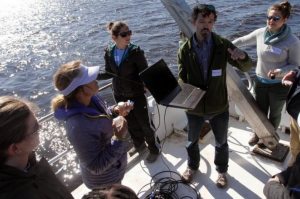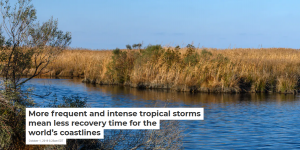




Faculty members from UNC-Chapel Hill got a first-hand look at the work done by the school’s Institute for Marine Sciences (IMS) in Morehead City during a tour of the Neuse River Thursday.
Dr. Nathan Hall demonstrates monitoring water quality on the Neuse River


Click the link below to read the full article!

Click the link below to find out what The Conversation is about
More frequent and intense tropical storms mean less recovery time for the world’s coastlines
Hi all,
I’m a little behind but here are the results from the last Neuse run on 9 July. It’s crazy how things have changed since spring when the estuary was basically a river. Salinities in the bottom waters of the lower estuary are as high as I remember seeing. The only other time that bottom waters at 180 have been this high was on 5 Oct 2002. Neuse river flows do not indicate that we are in as significant of a drought as in 2002. So, I think something on the ocean-side of the estuary might be playing a role in the high salinities and plan to see what our physical oceanographers think. The estuary was strongly stratified from New Bern to the mouth. Bottom waters were anoxic along much of the transect as evidenced by a strong sulfide smell. The crew will be out again next week.
Best,
Nathan
Hi all,
Salinity in the lower estuary is average for this time of year but the upstream section is a little fresher than normal. The basin saw quite a bit of rain in the second week of June and river flows are about four times higher than the seasonal average. The salt wedge penetrated upstream to station 50 just downstream of the HWY 17 bridge. Bottom water dissolved oxygen was low from the tip of the salt wedge through the length of the estuary but was only below 2 mg/L (acutely lethal to fish) at stations 50-70. A subsurface peak in chlorophyll a at about 1 meter depth occurred from stations 60 -100. Microscopic examination of the surface water sample from station 60S revealed high concentrations of the dinoflagellate, Gyrodinium instriatum. This dinoflagellate is a common bloom former during the warmer months in the Neuse and is not known to produce toxins or negative food web related impacts. Photosynthesis produced a zone of supersaturated dissolved oxygen at the stations with high chlorophyll. pH data are not shown due to probe failure.
Best, Nathan
Hi all,
For two and a half decades, ModMon has provided valuable information on water quality and habitat conditions in the Neuse River Estuary and Pamlico Sound. These data are crucial for evaluating how conditions are changing in response to human and climatic pressures. ModMon has also served as a platform to support research projects aimed at figuring out how estuaries work from ecological, geological, physical, and biogeochemical perspectives.
Conditions on 4 June 2019 were pretty typical for this time of year. Salinities ranged from zero above New Bern to a maximum of about 15 in the bottom waters near the mouth. Stratification was not particularly intense except at station 160 which was influenced by saltier bottom water likely from the Intracoastal Waterway. Hypoxic conditions occurred throughout most of the length of the estuary but were confined to a thin, ~1 m thick, layer near the bottom. A zone of high DO, high pH, and high chlorophyll a was observed at station 30 near New Bern. Microscopic examination of surface waters from station 30 revealed a high concentration of cryptophytes that are generally good food for higher trophic levels, and don’t cause problems.
Best,
Nathan
Hi all,
A couple of weeks without rain and the estuary is looking almost normal. The salt wedge is at New Bern and surface water salinity near the mouth was about 10. Most of the estuary was strongly stratified and bottom waters were hypoxic from stations 60 to 160. There was a peak in DO at station 50 that was likely due to high phytoplankton production. Microscopic observation of the station 50 surface sample showed a high concentration of small (3-5 um) centric diatoms. Chlorophyll data are not shown due to a failed probe. During the previous trip on 7 May, the chlorophyll probe of the YSI data sonde started to malfunction but the malfunction was not noticed until this trip on 21 May 2019. The bloom level chlorophyll a concentrations observed at station 50 on 7 were an artifact of this malfunction. The probe has been replaced and in vivo chlorophyll a data from both dates have been flagged in the data set.
A fish kill was observed a few days following this trip on 21 May, but no dead fish were noticed during a boat run from New Bern to station 100 on yesterday, 28 May. Based on the reports that I saw, the dead fish were mostly menhaden and had sores consistent with ulcerative mycosis caused by Aphanomyces invadans. This fungus is most virulent when salinities are low and temperatures are in the low to mid 20’s C; conditions observed during the fish kill. Fish that are already stressed, e.g. due to hypoxia, are more likely to suffer from the infection. I’ve attached a couple good papers for those interested.
Best,
Nathan
© 2024 The Paerl Lab
Theme by Anders Noren — Up ↑